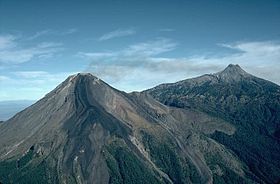Nevado de Colima
| Volcán de Colima | |
|---|---|

Volcán de Colima is on the left with Nevado de Colima on the right.
|
|
| Highest point | |
| Elevation | 3820+ m (12,533+ ft) |
| Prominence | 600 m (2,000 ft) |
| Listing | |
| Coordinates | 19°30′46″N 103°37′02″W / 19.512727°N 103.617241°WCoordinates: 19°30′46″N 103°37′02″W / 19.512727°N 103.617241°W |
| Geography | |
| Location | Jalisco / Colima, Mexico |
| Parent range | Trans-Mexican Volcanic Belt |
| Geology | |
| Age of rock | 5 million years |
| Mountain type | Stratovolcano |
| Volcanic arc/belt | Trans-Mexican Volcanic Belt |
| Last eruption | 2014 to Present (ongoing) |
The Volcán de Colima, 3,820 m (12,533 ft), also known as Volcán de Fuego, is part of the Colima Volcanic Complex (CVC) consisting of Volcán de Colima, Nevado de Colima (Spanish pronunciation: [neˈβaðo ðe koˈlima]) and the eroded El Cantaro (listed as extinct). It is the youngest of the three and as of 2015 is one of the most active volcanos in Mexico and in North America. It has erupted more than 40 times since 1576. One of the largest eruptions was on January 20–24, 1913. Nevado de Colima, also known as Tzapotépetl, lies 5 kilometres (3.1 mi) north of its more active neighbor and is the taller of the two at 4,271 meters (14,015 ft). It is the 26th-most prominent peak in North America.
Despite its name, only a fraction of the volcano's surface area is in the state of Colima; the majority of its surface area lies over the border in the neighboring state of Jalisco, toward the western end of the Trans-Mexican Volcanic Belt. It is about 485 km (301 mi) west of Mexico City and 125 km (78 mi) south of Guadalajara, Jalisco.
Since 1869–1878, a parasitic set of domes, collectively known as El Volcancito, has formed on the northeast flank of the main cone of the volcano.
In the late era, a huge landslide occurred at the mountain, with approximately 25 km³ of debris travelling some 120 km, reaching the Pacific Ocean. An area of some 2,200 km² was covered in landslide deposits. The currently active cone is situated within a large caldera that was probably formed by a combination of landslides and large eruptions. The lava is andesite containing 56-61% SiO2. About 300,000 people live within 40 km (25 miles) of the volcano, which makes it the most dangerous volcano in Mexico. In light of its history of large eruptions and situation in a densely populated area, it was designated a Decade Volcano, singling it out for study.
...
Wikipedia

